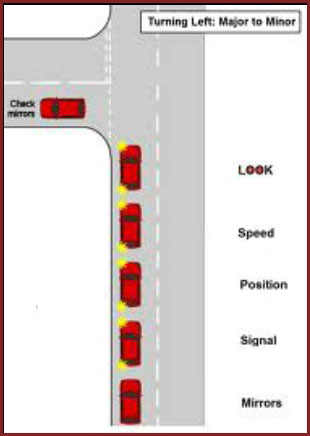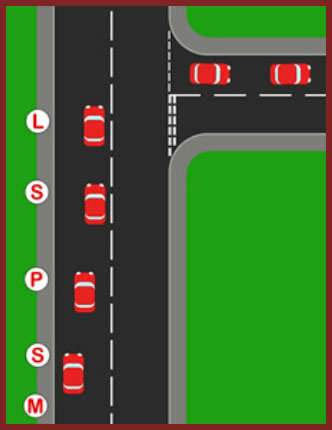 Planning An Approach to Turn Left Major to Minor
Planning An Approach to Turn Left Major to Minor
For this plan, let us assume:
Type: You are approaching a “T” Junction
Priority: You are on the Major road and turning into the Minor road – therefore you have priority unless pedestrians are crossing at the junction.
Open Or Closed Visibility?
Is visibility into the new road “Open” or “Closed?”
“Open” means you can see into the new road, which helps you to look for hazards. An early decision on your plan is usually possible if visibility is “Open.”
“Closed” visibility would mean that you may have to slow to a walk/crawl in order to be prepared to deal with what may be just around the corner.
Round Or Sharp?
Does the corner have a round or sharp curve? If it seems like the corner is more “sweeping” or “rounded,” and the access unobstructed, normally a “jogging” speed would be suitable. Second gear would usually match this speed. Be flexible though, and ready to adapt to suit a change in circumstance.
If the corner is very sharp it may be necessary to take it really slow in order to manoeuvre around it.
Tight Or Wide?
Is the width of the new road very “TIGHT” or are there any parked cars or obstructions just around the corner?
Where the new road is very narrow or narrowed by obstructions, there is a possibility of “meeting” traffic in it. A situation where obstructions make the new road very narrow often require more of a crawl/walk pace. 1st. Gear will match this speed in the “Really Good” tuition car. If the new road is “WIDE” and easily accessible, normally it would be more appropriate to a negotiate at a jogging speed – second gear.
Pedestrians?
Are there any pedestrians about to cross or crossing the road?
Pedestrians who have stepped onto the road have priority so be prepared to stop and allow them to cross if necessary.
Timing Of Signal?
Are there any roads to the left before the one I want?
If so, avoid applying a left signal until you are past that road, as another road user waiting in it may pull out, thinking you are about to turn into it.
All the above questions will help you determine the best course of action to take regarding the timing of a signal, your position of approach, your speed, and the gear you select. In simple terms, the more difficult the hazard is to negotiate, the slower you will generally need to approach.
It sounds like an awful lot to consider, but of course your “Really Good” instructor will be helping you develop these skills.
MIRROR-SIGNAL-MANOEUVRE.
Mirrors
Checking the interior first will give best view of approaching traffic and an idea of their speed.
Check left/nearside mirror next to be aware of any traffic that maybe about to pass on the left as you slow down to take turn, mainly cyclists/motorbikes.
Signal
Signal in good time but not too early, which may confuse other road users.
Position
There would be no need to change from your normal driving position unless there are obstructions (parked cars) or if you’re turning into a narrow road or entrance. For an exceptionally sharp turn you may need to move closer to the centre of the road.
Speed
SPEED THEN GEAR
Slow down enough to take turn safely based on the information you have gathered. Remember to bring clutch pedal up after changing gear to maintain control and avoid “coasting.”.
Look
Check into new road to assess how clear the junction is. Look out for parked cars and pedestrians who could be crossing the road. Make a final passenger door mirror check for any cyclists who may try passing you on the left, and let them pass without” cutting” in front of them to turn. Remember, pedestrians who have stepped onto the road have priority so be prepared to stop and allow them to cross if necessary.
After turning into the new road, check all your mirrors to make sure it is safe to accelerate away. Remember, someone could be attempting to overtake you, making it unsafe to accelerate.
Approach to Turn Right
 This time you need to give priority to oncoming traffic and pedestrians crossing the road.
This time you need to give priority to oncoming traffic and pedestrians crossing the road.
Mirrors
Check interior and driver’s side mirrors to make sure it is safe to change position, and if a signal is required.
Signal
Signal if you think anyone is around that may benefit. be careful to time the signal so as not to i intimidate or scare other traffic.
Position
The correct position to approach a right turn is:
On a very narrow road, keep well to the left.
On a wider road, move till your vehicle is just left of the centre of your approach road.
On a one way street, move over to the far right of the road.
Speed
As for turning left, make the same considerations regarding “Open” or “Closed,” “Tight” or “Wide,” but in addition you must give way to oncoming traffic whose path you would cross. One easy way to judge whether to give way is ask yourself, “would i walk across this road?” Normally, if you would walk, you would have enough time to drive across it.
Look
Keep looking ahead and to the right for changes in the road, if in doubt wait. Make a final driver’s door mirror check for anyone overtaking you just before turning. If clear, steer, looking out the driver’s door window to where you want the centre of your car to be in the new road. As you lose this view you will see the new road coming into view in the front window. As a general guide, begin to straighten your steering now.
Once in the new road check all your mirrors and if safe accelerate to an appropriate speed for the new road.
Initially. your instructor will guide you through the above procedure until you are controlled, competent, and confident. Once achieved, it’s on to the next stage!
